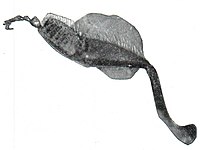
This picture shows how these cells will look under the microscope; and it shows something else. Notice that the point of meeting of the three sides of three cells is just opposite the center of the cell in the other side. Any carpenter, architect, mechanical engineer or your big brother in High School will tell you that this greatly increases the strength of the comb. You can see this back to back arrangement of a comb if you will hold one up to the light.

The queen bee reigns in the hive, and is treated with reverent courtesy and attention. When she moves about she is attended by a body guard, as seen in the picture. They form a circle about her with all their heads towards her. They walk backwards before her, and when they retire they move backwards, still facing their queen. They feed her with honey and bee-bread.
This picture shows that combs are not made only to hold honey, but to brace the little bee city— for that is just what a honeycomb is—so that it can't fall or be shaken down; as cities built by men sometimes are when they are shaken by earthquakes or struck by whirling winds.
If you ever find a beehive in the hollow of a tree, you will find these braces protecting it against the swaying of the trees in the wind. You will not find them in artificial hives.

When the workers go out into the fields for pollen to feed the babies, they carry along "market baskets." These baskets, as you see in this picture, are on the outside of each pair of hind legs. Both body and legs are covered with hairs which collect the pollen. The bees scrape the pollen off one leg with the other and put it into the basket. You have noticed the flies have the same habit. Bees do most of their collecting within two miles of the hive. The pollen is first rolled into a ball before it is dropped into the basket. The baskets are arched over with hairs to protect these little balls from falling out. Sometimes the bees roll in the flower so as to get themselves all covered with pollen—just as you have seen horses roll, or a bird utter dust over himself.


